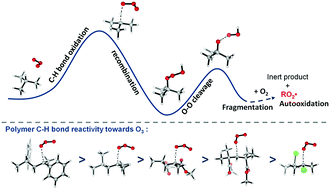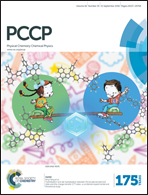Mechanistic insights into ozone-initiated oxidative degradation of saturated hydrocarbons and polymers†
Abstract
Accurate quantum chemical calculations were employed to investigate the mechanism of ozone-initiated oxidation of C–H bonds of saturated hydrocarbons and polymers. Step wise hydrogen atom abstraction generates the first resting state the trihydroxide –COOOH, which undergoes decomposition to produce the free radical species alkoxyl –CO˙ and peroxyl ˙OOH thereby setting off a complex chain of radical processes. The H transfer from peroxyl radical to alkoxyl allows formation of inactive alcohol and the singlet excited dioxygen. Other competitive processes include the self fragmentation or β-scission of the alkoxyl –CO˙ to give rise to a carbonyl (ketone or aldehyde) and a C-centred free radical species. Tertiary C–H bonds are most susceptible to O3 oxidation followed by secondary and primary. Among the polymers studied, poly(styrene) is the least resistant to C–H bond ozonation, followed by poly(propylene), poly(methacrylate), poly(methyl methacrylate) and poly(vinyl chloride). Calculations also reveal catalytic effects of water in promoting the C–H bond oxidation process in polymer systems without competing H-bond donor groups.



 Please wait while we load your content...
Please wait while we load your content...